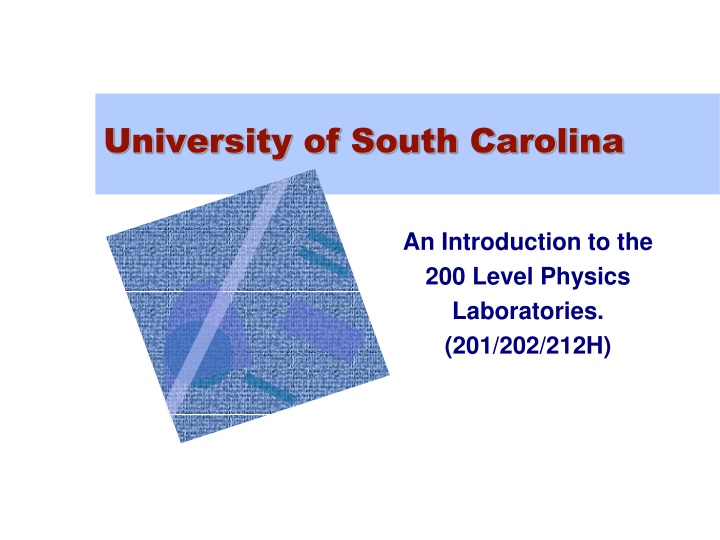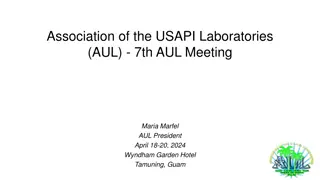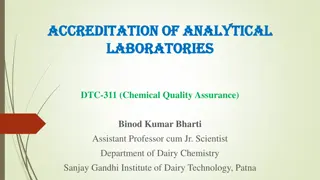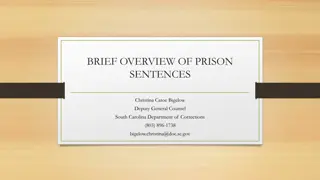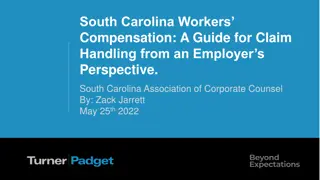Introduction to University of South Carolina 200 Level Physics Laboratories
Explore the eligibility requirements, relation to your course, objectives, course outline, and communication details for the University of South Carolina's 200 Level Physics Laboratories. Gain hands-on experience in experimental techniques, collaboration, and presentation skills in this scientific research-oriented lab setting.
Download Presentation

Please find below an Image/Link to download the presentation.
The content on the website is provided AS IS for your information and personal use only. It may not be sold, licensed, or shared on other websites without obtaining consent from the author.If you encounter any issues during the download, it is possible that the publisher has removed the file from their server.
You are allowed to download the files provided on this website for personal or commercial use, subject to the condition that they are used lawfully. All files are the property of their respective owners.
The content on the website is provided AS IS for your information and personal use only. It may not be sold, licensed, or shared on other websites without obtaining consent from the author.
E N D
Presentation Transcript
University of South Carolina An Introduction to the 200 Level Physics Laboratories. (201/202/212H)
Eligibility To be eligible for enrollment in PHYS 2xxL you must satisfy any of three conditions: A. Be currently enrolled in PHYS 2xx. B. Already have a grade of C or better in PHYS 2xx. C. Have a written waiver from the Undergraduate Director. You will not receive a passing grade in PHYS 2xxL if you do not meet one of these conditions at the end of the semester. Warning: If your eligibility depends on current enrollment and you drop PHYS 2xx, you must independently drop PHYS 2xxL. same
Relation to your course If you are currently in a 200 level physics course (201/202/212H), you will find that the course and lab do not sync up. You may do experiments in lab that you have not covered the theory for in your course.
Objectives Laboratory is organized to reflect the activities of scientific research. Preparation: textbook Experimental trial and error Collaboration Presentation We use physics as an example of science. Learn how a science is done, not only the results.
Objectives Develop experimental techniques. Maintain laboratory notebook. Prepare apparatus. Observe and record. Analyze. Use the graph as an analysis tool. Prepare a technical oral presentation.
Course Outline Four 3-day cycles Two projects in progress during each cycle. Each student does each of the projects during the cycle. In each cycle students will form groups of two as directed by the instructor. Work on project A in day 1 of cycle. Work on project B in day 2 of cycle. Oral presentations on day 3.
Course Outline In each cycle every student will: Participate in the lab project. Take the necessary data (group). Submit a final project report for each project (group or individual). In each cycle 1/4 of the students will individually present one of their projects orally. Each student will make exactly one presentation during the semester.
E-mail Faculty, instructors, and staff associated with the labs have e-mail addresses posted on the Web. Students are presumed to have an active e-mail address. Primary contact with your instructor, outside of lab, will be through email.
Required Materials The Student Laboratory Notebook, University of South Carolina, Physics 201L, 202L, 211L, 212L, published by Hayden McNeil buy it at the bookstore A plastic ruler with both inch and metric units A protractor Print your project description and bring it to class. Using a mobile device is accepted (laptop, tablet, etc.) The lecture textbook (optional, but encouraged) This is your primary physics reference
Laboratory Notebook Key piece of equipment for any scientist. It is valuable and irreplaceable: Guard it Carefully. You should record Data and observations about the experiment. Calculations. Draft graphs and diagrams. Draft answers to questions. In short, almost everything goes in the notebook. The exception being the final project report (typewritten).
Project Description Format All project descriptions are available on the 200 level lab web page: www.uof.sc/physlabs Objective: describes the goal of the project Equipment: a list of the equipment used. Data collection procedure
Project Description Format Calculations, Graphs and Diagrams: a list of required graphs and diagrams and the calculations necessary to produce them 1a, 1b, indicate multiple data sets plotted using a common set of axes. Graphs with differing numbers should appear in separate figures with independent sets of axes. Questions: to be answered in your report
Printing Project Descriptions Find project descriptions via www.uof.sc/physlabs Print or download just the ones you need. No project description is more than ten pages. Don t print too early. Descriptions are subject to last minute revision. One day before start of cycle is OK. Bring the print outs or use a digital device to have the project descriptions on hand.
Cycle Outline 1st day preparation Print all projects for this cycle from the webpage and read carefully. Study pertinent sections of textbook. 1st day in lab Assemble apparatus, take data, make preliminary graph (if required) for project A . Have lab instructor grade your lab notebook. This grade serves as a preliminary lab report grade for project A and does not include the questions.
Cycle Outline 2nd day preparation Review project B description from the webpage and read carefully. Study pertinent sections of textbook. 2nd day in lab Exchange between North and South sides of room Submit final lab report for project A . Assemble apparatus, take data, make preliminary graph (if required) for project B . Have lab instructor grade your lab notebook. This grade serves as a preliminary lab report grade for project B and does not include the questions.
Cycle Outline 3rd day preparation Prepare final project report for project B . Prepare presentation (presenters only). 3rd day in lab Submit final project report for project B . Deliver oral presentation (presenters only). Receive assignments for following cycle (determines partner and projects).
The Presentation Session Each presentation lasts 10 minutes or less. After presentation for one project the instructor will lead a discussion (if needed). The next presentation will prepare at the instructors request. Repeat.
Presentation Preparation Prepare presentation following guidelines in the how-to. Organize your material. Prepare the required slides PowerPoint suggested Rehearse. Check that your material realistically fits within the allotted time. Presenters must be prepared for questions.
Project Report Text, including major equations but exclusive of endnotes, data, and figures, must not exceed 150 lines in a font no smaller than 10 pt (may not be hand-written). You face a tough challenge to distill your report to fit this requirement demands thought and skillful writing. Use endnotes for attribution of sources. Optionally include ancillary material in appendices, but your instructor is under no obligation to read them. Graphs and figures may be hand-drawn, but legibility is essential.
Project Report A group may by agreement submit a single project report with signatures of both partners on the cover. Partners will receive identical grades for the report. Partners may independently submit project reports. Partners will receive independent grades. Be respectful of your partner try to capitalize on his strengths, compensate his weaknesses, and stimulate him to do his best work, i.e. collaborate.
Rotation The tables in a row will never have the same project (although some equipment may be in common). To switch from project A to project B students will cross the aisle from north to south or vice versa remaining in the same row. At the 1st working session of a cycle, if not sooner, the instructor will assign the presenters for the cycle and the projects they are to present.
Rotation Today your instructor may assign you to a table for cycle 1. At the end of cycles 1 and 2 your instructor may reassign you to a table and a new partner for the following cycle. To the extent possible students will work with a new partner in each cycle. Students will be presenters exactly once.
Grading 8 prelim reports(each out of 12, up to 96 pts.) 8 final reports (each out of 30, up to 240 pts.) 1 oral presentation (50 pts.) Each unexcused absence a penalty of -15 pts. plus loss of credit for missed work Class participation (up to 14 pts.)
Grading Scoring 280-299 Score 360-400 340-359 320-339 300-319 Grade A B+ B C+ C D F 240-279 0-239 Late submissions Tardy receipt of documents will be considered the fault of the student no matter what the reason.
Grading Your instructor will strive to be as fair as possible in their grading, but The grades are in the last analysis subjective. Do try to impress your instructor with your knowledge and your skill they can t credit what they can t see.
Attendance Policy Attendance is mandatory Excused absences 1 or 2 has no direct effect on grade. You are nonetheless responsible for work missed. Discuss missed presentations with your instructor. More than two excused absences may result in an incomplete (I) for the course. Absences exceeding two may be excused if they are provably attributable to a communicable disease.
Attendance Policy Ordinarily an excused absence must be arranged with the instructor in advance: Use e-mail or telephone as necessary to be timely. An excused absence requires an explanation On official stationary (letterhead, prescription pad, etc.) Dated and signed by a person of authority (doctor, minister, judge, attorney, dean, professor, etc.). A note from a friend or parent is not sufficient. An absence to be excused because of unforeseeable misfortune requires a letter from Undergraduate Student Ombuds Services. See Exigencies below.
Attendance Policy In case of demonstrable emergency, where the student shows convincingly that advance notification was infeasible, the course supervisor may excuse the absence. Unexcused absences: Each absence a penalty of -15 pts. plus loss of credit for missed work. 2 in same cycle or more than two total may result in a grade of F for the course.
Tardiness Policy Tardy arrival at class by more than 40 minutes will constitute an unexcused absence. Tardy arrival by 20 to 40 minutes will be automatically excused on the first occasion. Tardy arrival by 20 to 40 minutes on the second and subsequent occasions will constitute an unexcused absence. Tardy arrival by less than 20 minutes will not be formally penalized, but it will not endear you to your lab partner nor to your instructor.
Exigencies Q: What if mid-semester you suffer some misfortune, e.g. illness, accident, or family hardship? A: Your TA may consider a request for some accommodation provided that you meet the following criteria. 1. At the earliest opportunity you have notified your TA about your situation. 2. The Office of Student Advocacy has provided a letter in support of your request. https://www.sc.edu/about/offices_and_divisions/student_affairs/ou r_initiatives/academic_success/ombuds_services/ 3. You are up to date in the course or nearly so at the time that the misfortune strikes. You must also satisfy these criteria in the case that you are requesting an Incomplete for the semester.
Safety Always ... Turn off power supplies when changing electrical circuits; Power down and unplug all electrical equipment at end of class; Report broken equipment to instructor as soon as feasible;
Safety Never ... Shine a laser in anyone s eyes; Fire projectiles in the direction of others; Bring food or drink into the laboratory; Use equipment for other than the intended purpose. Disregard of these or other common-sense safe practices will result in dismissal from the course!
Personal Safety If you are in a late lab and have safety concerns, you may also want to call 777-DUCK, APO Student Escort Service. Take advantage of your campus resources. Carolina Shuttle evening routes
The Road to Success Work safely. Preparation Take advantage of your resources. The lecture text Project descriptions and how-to documents The library Your partner and the other groups doing the same project Your instructor Web resources Success.
The Road to Success Your partner and other students are resources Generally two or more groups work on the same project. When you have a question First, ask your partner. Next, check the lecture text and project description. Third, ask another group doing your project. If you still do not have an answer, ask the laboratory instructor.
The Road to Success Realize that confusion is to be expected If you are confused, then you have the opportunity to learn something! If you are taking the corresponding lecture course contemporaneously, you will encounter some topics first in lab. It s more fun to learn it in lab. You will be better prepared for the lecture course. You can defer the lab to a later semester.
The Road to Success Much of what you can learn in this course is directly applicable to any line of scientific or technical pursuit. Engineers and pre-meds take note! Your instructors have fun doing science and especially physics. They aim to make a career of it. They would like you to share in that fun.
Closing Thought If we teach only the findings and products of science - no matter how useful and even inspiring they may be - without communicating its critical method, how can the average person possibly distinguish science from pseudoscience? Carl Sagan
